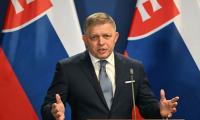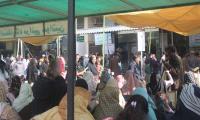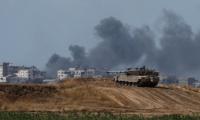Islamabad : In the grand narrative of global collaboration and economic connectivity, the Belt and Road Initiative (BRI) stands as an orchestrator, weaving together nations in a harmonious symphony of progress.
As the Initiative goes beyond the conventional realms of infrastructure development of highways, railways and energy projects, it is also a catalyst for economic growth and prosperity having transformative dimensions into economic, cultural and geopolitical domains.
By creating a network of interconnected projects, BRI unveiled in 2013, facilitates seamless flow of goods, services and investments across participating nations that stimulates local economies creating conducive environment for innovation and collaboration.
At the heart of this transformative initiative lies a strategic masterpiece the China-Pakistan Economic Corridor (CPEC) the flagship program for Pakistan envisaging economic turn around and ameliorating the lot of debt stricken people.
The CPEC stands tall, symbolizing the ambitious spirit of this initiative as we celebrate a decade of BRI and CPEC.
This feature explores the monumental strides made, the challenges faced and the promises that echo through the corridors of this economic alliance.
Prime Minister Anwar-ul-Haq Kakar, during discussions with Chinese Premier Li Qiang, emphasized the vital role CPEC plays in Pakistan’s economic landscape.
The expansion of CPEC into diverse areas, from industrial development to information technology, paints a picture of dynamic growth.
"We have already achieved CPEC''s first phase and we are benefiting from its early harvest projects.
Now, we are entering the second phase, the Premier had also informed China Global Television Network (CGTN) in an interview during his visit to Davos.
Both sides are engaged and we have developed a lot of connectivity - road, air and rest of connectivity corridor. We are also benefiting from bilateral trade.
Chinese President Xi Jinping, at the Third BRF had also emphasized the global expansion of Belt and Road cooperation stating that CPEC, as an integral part, is pivotal in building close China-Pakistan community with a shared future.
Spanning over 3,000 kilometres, the CPEC stands as the strategic artery of the BRI, connecting Gwadar Port to southwestern Pakistan and China’s Xinjiang region as a comprehensive endeavour encompassing highways, railways, and energy infrastructure.
Celebrating the ten-year milestone at the Third Belt and Road Forum, China and Pakistan reaffirmed their commitment to multifaceted development and carry forward the vision behind this undertaking to enhance multi-faceted ties.
The $62 billion CPEC infrastructure has spurred economic development in Pakistan besides providing China an outlet for its excess industrial capacity and opportunities for other nations to join the project and reap benefits of enhanced connectivity.
Chinese Foreign Ministry Spokesperson Wang Wenbin has also recently reiterated China’s readiness to work with Pakistan to upgrade CPEC.
China stands ready to work with Pakistan to deliver on important common understandings between the leaders of two countries, deepen political mutual trust and expand practical cooperation, he had informed during a regular media briefing.
As CPEC strides towards fruition, the completed projects under CPEC valued at $24 billion and ongoing ventures of $5 billion underscore tangible results of this collaboration and positive reverberations beyond borders of China and Pakistan.
The impact of CPEC is felt on multiple fronts, generating 236,000 jobs, producing 8,000 megawatts electric power, constructing over 510 kilometres highways and expanding national transmission network by 886 kilometres.
“CPEC has influenced multi-sectors development in Pakistan’s and it could be done due to an approach of Shared Future between China and Pakistan,” stated Dr Nadeem-ul-Haq, Vice Chancellor Pakistan Institute of Development Economics (PIDE).
Dr Nadeem-ul-Haque, who also served as Deputy Chairman Planning Commission, said that CPEC s socio-economic impact was directly linked to SDGs framework, by and large followed by Pakistan.
CPEC is benefitting Pakistan in many areas and realizing its full potential make Pakistan achieve more development goals.
The potential for transforming the region, creating opportunities for Iran, Afghanistan, and Central Asian Republics, is becoming increasingly evident.
While the first phase witnessed remarkable progress, the second phase (2021-25) sets its sights on industrialization, agriculture modernization, and socio-economic development.
The CPEC-Long-Term Plan (2015-30) also paves way for new avenues in tourism, mines and minerals and the petroleum sector.
“Challenges are acknowledged, but the belief in the power of collaboration remains unshaken.
Pakistan performed well during first phase of CPEC and this could happen due to good coordination by both sides,” said Economic Affairs and National Development Advisor at Centre for Aerospace and Security Studies Dr Usman W. Chohan.
“Yet, we need to do more for industrial and agriculture sectors where the two sides had already worked out an action plan with consensus,” Chohan said.
Accelerated work on CPEC as an important component of BRI would help Pakistan establish strong links with global and regional economies.
As the Belt and Road Initiative enters a new decade, China-Pakistan Economic Corridor stands as a testament to the transformative power of collaboration. It’s not just about infrastructure; it’s about shared dreams, collective progress and a future where opportunities know no borders. Challenges will undoubtedly arise, but the symphony of BRI and CPEC plays on, shaping the destinies of nations and resonating across the landscapes of economic and cultural connectivity.
The picture released on March 6, 2024 shows Waqar Shah -Deputy General Manager at an event. —...
Participant speaks during the 7th International Conference on Patient Safety at Jinnah Convention Center on May...
The image released on June 8, 2023 shows the building of the Quaid-i-Azam University . —...
Rawalpindi Arts Council can be seen in this image. — APP/FileRawalpindi:The Punjab Council of the Arts Rawalpindi...
The book cover of "Dear Mr Jinnah" by Salman Faruqi. — Dawn.com/FileIslamabad: A new 432 pages book titled ‘Dear...
This image shows the logo of the Attock Petroleum Limited . — Facebook/Attock Petroleum Limited...







